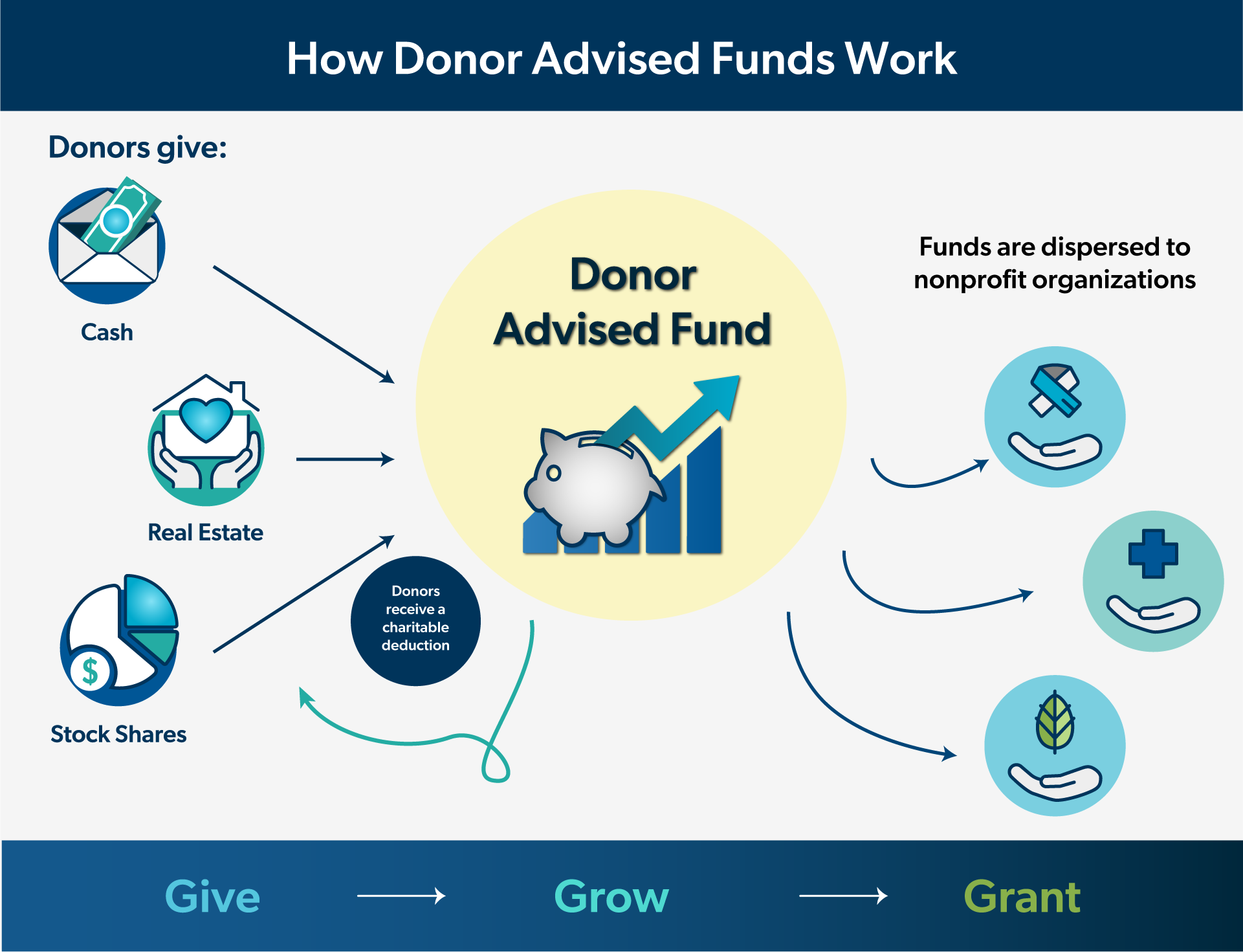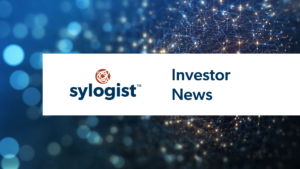2024 Giving Trends – Donor Advised Funds
How nonprofits can maximize Relationships with Donor Advised Funds with SylogistMission CRM
In 2024 we’ve been reviewing the most important nonprofit fundraising trends and we’ve got some great suggestions that every nonprofit fundraiser should read.
Unlocking the Mystery of Donor Advised Funds
Donor Advised Funds (DAFs) are becoming a go-to vehicle for major charitable giving, especially among mega donors. In essence, DAFs are funds that allow donors to contribute cash, stock shares, and even real estate holding which are then distributed to charitable organizations based on the donor’s recommendations.

As of 2022, DAFs held more than $228 billion in assets according to the National Philanthropic Trust’s 2023 DAF Report, making them a significant resource for nonprofits to tap into.
Minimal regulations compared to other donations
Donor Advised Funds, or DAFs, are quickly becoming the preferred method that mega donors are giving to charity. Each DAF has different rules for how and when the money is dispersed to charitable organizations. There are relatively few regulations that govern DAFs in the United States and Canada.
Regulations in the United States
In the US, DAFs are regulated primarily through the Internal Revenue Code (IRC). Key regulations include:
-
501(c)(3) Status: Organizations that sponsor DAFs must be public charities under IRC Section 501(c)(3). This includes community foundations and charitable arms of financial institutions.
-
Donor Control: Donors may advise on grants made from the fund, but they do not retain legal control over the assets once contributed. The sponsoring organization has final say on how funds are distributed.
-
Tax Deductibility: Donations to DAFs are tax-deductible in the year they are made, subject to IRS limitations (up to 60% of adjusted gross income for cash gifts and 30% for appreciated assets).
-
Distributions: While no strict law requires annual distributions, there has been debate about implementing a mandatory payout similar to private foundations. Currently, sponsoring organizations encourage or have policies regarding distributions to ensure funds are used for charitable purposes.
-
Prohibited Benefits: Donors cannot receive personal benefits, such as tickets to events, in exchange for a grant from a DAF. Likewise, DAFs cannot make payments that satisfy a donor’s personal pledge.
Regulations in Canada
In Canada, DAFs are governed under Canadian federal law, particularly by the Income Tax Act (ITA) and overseen by the Canada Revenue Agency (CRA).
- Registered Charities: Similar to the U.S., only registered charities under the ITA can offer DAFs, and they must comply with CRA regulations.
- Donation Receipt: When donors contribute to a DAF, they receive a tax receipt for the full value of the donation, which can be claimed for tax credit purposes
- Disbursement Quota: Registered charities, including those offering DAFs, are required to meet a disbursement quota—currently set at 3.5% of their assets annually. This ensures that a portion of the funds are distributed for charitable purposes each year.
- Control of Funds: Like in the U.S., donors can advise on how the funds are distributed, but the charity must retain ultimate control over the disbursement decisions.
- No Private Benefit: Donors cannot receive personal benefits or fulfill personal obligations through DAF disbursements.
In both countries, the key principle is that DAFs are meant to facilitate charitable giving without offering personal control or direct benefits to donors beyond the initial tax advantages.
Why donors are flocking to DAFs
DAFs are appealing to donors due to their tax advantages and flexibility in donation timing. Donors can contribute to their DAFs at any time, receiving immediate tax benefits while deciding later on when and where to distribute the funds.
- Immediate tax benefits
- Immediate deduction: Donors receive an immediate tax deduction when they contribute to a DAF, even if they don’t distribute the funds to charities right away. This allows donors to plan their giving over time while taking advantage of the deduction in the year of the contribution.
- Flexibility in timing: The contribution is deductible immediately, but donors can decide later when and where to distribute the funds. This is especially useful for donors wanting to maximize deductions in high-income years.
- Simplicity and convenience
- Easy management: DAFs provide an easier alternative to setting up a private foundation. The sponsoring organization handles administrative tasks, such as record-keeping, compliance, and reporting.
- Consolidated giving: DAFs allow donors to manage all of their charitable giving in one place, making it simpler to track contributions, distribute grants, and maintain a giving strategy.
- Investment growth
- Tax-free growth: Funds in a DAF can be invested and grow tax-free. This allows for potentially larger future grants to charities, as the assets increase in value over time.
- Professional management: DAF sponsors often provide investment options managed by professionals, offering donors a hands-off approach to growing their charitable fund.
- Flexibility and control over grants
- Advisory role: While the donor gives up legal control of the assets, they retain advisory privileges on where the funds are granted. This allows donors to be actively involved in their charitable strategy over time.
- Multi-year giving: Donors can make contributions in one year and spread the grants to different charities over multiple years, allowing for strategic philanthropy.
- Anonymity
- Anonymous giving: Unlike foundations, which are required to disclose their financials and grant recipients, DAFs allow donors to give anonymously. This can be appealing for those who want privacy in their philanthropy.
Mega Anonymity for Mega DonorsAccording to a 2024 article in Inside Philanthropy, Google founders Sergey Brin and Larry Page now rank in the top 40 in terms of grantmaking in the United States. Brin’s family foundation more than doubled contributions in 2022 with over $512 million donated. Page’s foundation granted 40% more in 2022, with $276 million given.
Both Brin and Page have foundations which submit public 990-PF form (returns of private foundation) but neither Brin’s nor Page’s foundations have a website or any other public presence. The Sergey Brin Family Foundation gives funds directly to charities, with $150 million given to the Michael J. Fox Foundation, $50 million to Stanford University, and $40 million to the Climate Imperative Foundation.
Conversely, one must look at the Carl Victor Page Memorial Foundation’s 990-PF forms to get a rough idea of the total amount of donations. According to a measure by Forbes, almost all, save for a $1000 donation to the American Cancer Society, of Page’s $276 million in 2022 giving went to DAFs.
- Anonymous giving: Unlike foundations, which are required to disclose their financials and grant recipients, DAFs allow donors to give anonymously. This can be appealing for those who want privacy in their philanthropy.
- Low costs
- Lower setup costs: DAFs are generally much less expensive to set up and maintain than private foundations, which involve legal, accounting, and administrative costs.
- No excise tax: Unlike private foundations, DAFs are not subject to the 1-2% excise tax on net investment income.
- Legacy planning
- Family philanthropy: Many donors use DAFs to involve their families in charitable giving, passing on the advisory role to children or other heirs. This allows for creating a philanthropic legacy that can continue across generations.
- Succession planning: Donors can name successors to advise on the fund after their passing, allowing for long-term charitable impact.
Varying outlooks
While donors love the flexibility DAFs offer, this lack of disbursement regulations also raises concerns, especially for nonprofits. Payouts from DAFs decreased from 28.7% in 2021 to 22.5% in 2022, leading critics to question the lack of governance around when funds should be disbursed.
Positive views
- Steady stream of donations: Many nonprofits appreciate DAFs because they can provide a steady flow of donations over time. Donors can make larger initial contributions to a DAF and then distribute the funds to nonprofits incrementally, often providing ongoing financial support.
- Engaged donors: Donors who use DAFs tend to be more engaged in philanthropy. Nonprofits may benefit from deeper relationships with these donors, who often take a more strategic and long-term approach to their giving.
- Larger gifts: Because DAFs allow for the tax-free growth of funds, nonprofits may receive larger gifts when donors decide to make grants after their investments have appreciated.
Concerns over disbursement
- Delayed funding: One of the primary concerns nonprofits have about DAFs is that donors are not required to distribute funds within a certain timeframe. As a result, some nonprofits worry that significant charitable dollars remain idle, even when there is an urgent need for funding in the nonprofit sector.
- Lack of transparency: Since DAFs don’t have to disclose detailed information about their grants, nonprofits often find it challenging to identify potential funders and understand how much money is available for charitable giving. This can make it harder for them to build relationships with DAF donors.
- Growing DAF balances: Some nonprofits criticize the growing accumulation of assets in DAFs. They argue that these funds, while earmarked for charitable purposes, are not making an immediate impact. In the United States there is no mandatory payout rate (unlike private foundations, which are required to distribute 5% of assets annually). In Canada, DAFs are required to disperse 3.5% annually. Nonprofits are concerned that this delay in disbursement reduces the funds available to address current social and environmental needs.
Advocacy for reform
- Calls for mandatory payouts: Many nonprofit leaders and philanthropic advocates have pushed for reforms to require minimum annual disbursements from DAFs, similar to the rules governing private foundations. Proponents argue that this would ensure more money is consistently flowing to charitable causes rather than sitting in DAF accounts indefinitely.
- Balancing flexibility and need: Some nonprofits recognize the value of DAFs’ flexibility for donors but believe a balance should be struck between allowing donors time to plan their giving and encouraging timely disbursements to meet pressing needs.
While nonprofits value the charitable potential of DAFs, many express concern about the lack of disbursement requirements, which can delay funding and reduce the immediate impact of philanthropic dollars. There is ongoing debate in the nonprofit sector about whether DAFs should be subject to more regulation to ensure a steady flow of funds to nonprofits.
While some DAFs are small and family-owned, others, like Fidelity Charitable’s, manage billions of dollars. The varying structures and rules surrounding DAFs present both opportunities and challenges for nonprofits seeking to engage DAF donors.
Donor Advised Funds are growing rapidly, but nonprofits need to understand their structure and limitations to maximize their fundraising efforts.
Engaging with DAF Donors Through SylogistMission CRM
Despite concerns over governance, proactive nonprofits can still find success in engaging with DAF donors by understanding how to effectively communicate and provide the right opportunities. SylogistMission CRM allows nonprofits to track donor relationships, identify DAF contributions, and create personalized outreach that keeps the organization top-of-mind when DAF donors are ready to make distributions.
DAF donors often look for flexibility in their giving options, and SylogistMission CRM’s donor segmentation tools enable you to tailor your engagement strategies based on each donor’s preferences, including DAF usage.
Nonprofits must be proactive in engaging DAF donors. SylogistMission CRM helps build and maintain these critical relationships through targeted outreach.
Streamlining the DAF Grant Process
Managing grants from DAFs can be complex, but SylogistMission CRM simplifies this process by providing tools that streamline grant tracking and communication. Nonprofits can manage the entire lifecycle of a DAF contribution, from the initial recommendation to the final receipt and acknowledgment. Automated workflows ensure timely responses, making it easier for nonprofits to manage and build trust with DAF donors.
SylogistMission CRM offers tools to manage DAF grant processes efficiently, enabling nonprofits to focus on stewardship and long-term donor retention.
Data-Driven Insights for DAF Fundraising
One of the advantages of SylogistMission CRM is its robust data analytics, which allows nonprofits to track DAF-related trends and donor behavior. By analyzing this data, nonprofits can refine their fundraising strategies, focusing on high-potential DAF donors. Understanding when DAF donors are most likely to make distributions helps nonprofits tailor their communications and campaigns to align with donor giving patterns.
Leveraging data-driven insights helps nonprofits optimize their DAF fundraising strategies, allowing them to engage donors at the right time with the right message.
Communicating Impact to DAF Donors
Impact reporting is essential to maintaining strong relationships with DAF donors. SylogistMission CRM makes it easy to create personalized, data-rich reports that demonstrate the impact of a donor’s contribution. By sharing regular updates on how DAF grants are being used, nonprofits can strengthen donor relationships and encourage ongoing support.
As more young donors gain wealth and are motivated by social impact, effective communication of outcomes becomes even more critical. Younger generations want to see the tangible effects of their giving, and SylogistMission CRM empowers nonprofits to meet these expectations through detailed impact reporting.
SylogistMission CRM helps nonprofits deliver the detailed impact reports DAF donors want, ensuring they remain engaged and motivated to give.
Donor-Advised Funds are an increasingly popular giving method, particularly among mega donors. While there are challenges in navigating DAFs, nonprofits can thrive by understanding the structure and opportunities they present.
SylogistMission CRM offers the tools necessary to engage DAF donors, streamline grant processes, and deliver impactful reports, helping nonprofits maximize the potential of DAFs and strengthen donor relationships.
RK Richards, Solution Architect for SylogistMission ERP
The nonprofit industry is at an inflection point. Nonprofit fundraisers are already using AI tools, but leaders are searching for the right path forward. According the 2024 Work Trend Index Annual Report from Microsoft and LinkedIn, the use of generative AI has nearly doubled in the last six months alone and 75% of respondents said they use AI tools to help them save time, focus on building relationships rather than administrative tasks, and enjoy their work more.
Many nonprofits lack clear guidance on AI usage meaning the organization misses out on the opportunity to implement AI at scale and the usage of free, open-data model AI tools opens the organization up to data security problems.
- Understand the power of AI tools for nonprofits
- Preview real-world applications to increase transparency & demonstrate impact
- Learn about the magic of natural language
Register now
Additional resources:
AI for Nonprofits 102 – A Lesson in Vocabulary
Top 7 Charitable Giving Trends to Watch in 2024
2024 Trend: Cloud-Based and SaaS Software Charitable Giving Across Generations



